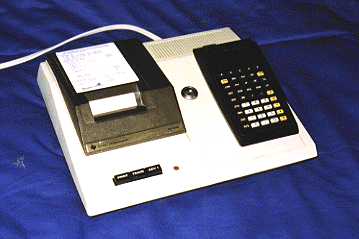|
(w/ PC-100C Thermal Printer Unit)
The first experience I had actually programming a computing device was with a Texas Instruments programmable calculator. I was a lifeguard at a municipal swimming pool, and the guy who ran the place was an engineering school flunkie. He had this nifty calculator at work, and when I asked him about it I learned that it was "programmable." He wound up lending it to me, along with the manual, and I started playing with it. The calculator would store instructions, execute them in the specified order, transfer the flow of control based on decisions (if x > y, etc.), store multiple values, and many other functions. At the time I didn't even really realize that I was "programming," but in fact it was very similar to what I would later learn to be Assembly Language. The programming language that the calculator used was essentially the calculating functions it had available on the key pad. All I knew was that it was a lot of fun to play with. I eventually used it on my calculus final in High School. We were given a differential equation to solve and plot on a graph. It involved highly repetitive calculations, each one determining one of the many points on the graph. While other students started performing calculation after calculation, I got busy programming the equation into my calculator. After some testing and debugging, the program was ready to go. By this time everyone else in the class was about a third of the way through the graph, and I'd yet to plot a single point. But I set the program in motion and began to plot point after point. Within a minute or two I was done, and everyone else still had two-thirds of the way to go. The item pictured above was the TI-59 Programmable Calculator. The one I had used was a little older and more primitive. The TI-59 had essentially the same functionality, but it could store more instructions and data elements, and it had this nifty feature where you could feed a little magnetic strip into the unit. It was the coolest thing in the world. You'd slip it in a little slot on the right side under the LED display, and it would buzz as it drew it in and spit it out the left side. The magnetic strips would store programs, so you wouldn't have to type them in every time you turned the calculator on, like the one I had been using. It also had available the PC-100C Thermal Printer Unit, also called a "cradle." You'd take the battery pack out of the back of the calculator, leaving a large square opening and cavity. You'd place this cavity over the mounting bracket on the printer, lock it into place, and it would get its electric power from the unit and communicate with the printer. There was a charging hookup for the battery pack, so that it could be recharging while the calculator was mounted on the printer. One of my best friends in High School scored a TI-59 complete with PC-100C Thermal Printer Unit. He got it at the Lake Placid Olympic Garage Sale. We grew up a couple hours from Lake Placid, and after the 1980 Winter Olympics there was a huge sale to get rid of a lot of the equipment they had left over. My friend got the unit pretty cheap. The problem was he never used it. We played with it a little bit whenever I came over to visit, but he never really learned how to program it, and certainly never put it to any kind of use. In subsequent years I would plead with him to sell it to me, but he insisted on charging me the original retail price, which I was unwilling to pay. I eventually picked one up off eBay, which is the unit pictured above. If you're curious how to program a TI59, click here for my how-to guide. For pix and info about dozens of other calculators by Texas Instruments and other manufacturers, see the Datamath Calculator Museum
|
